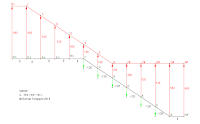I have heard that many harpsichordists only learn 2 or 3 tunings.
If this is the case one of them ought to be Haugsands tuning !
In the following text I want to show the possibilities of Ketil Haugsands flexible temperament.
I recommend you to see his two videos unless you know the tuning from before.
Here: Haugsand tuning,Youtube
It is easy to remember and it is quite easy to tune .
But not least it can function according to the use of extreme 0 hz to (about equal at) 10 Hz.
But what happens to all the chords at the very different varieties?
Here we can get some help from the diagrams.
(If you do not know the diagrams from before I recommend Main Introduction (link).)
We will focus most on the major third now, the longer red vectors / (higher the values), the more impure is the major third (No red vectors means a pure major third)
The numbers you can relate to are 420 TU which is the size of an third in Equal Temperament,
and 660 TU for a Pythagorean third (eg , after 4 subsequent pure fifths)
A horizontal line means a pure fifth.
If you want to compare the fifths here to different fractions of comma:
Click this link !
It is never any problematic fifths in all varieties of Haugsand tuning !
Let's look at 2.5 Hz (you can click on the picture)
As always in Haugsand it is the five major thirds from F major to A major which are good. And here they are extremely good. The major thirds are from 80 to 128 TU and all major thirds are good from Eb major to B major.
But the purer major thirds are and the more we get of them we unfortunately have to pay to the same degree to some other major thirds. And the temperament becomes therefore very abrupt as we see here, since both fifth-lines go their separate ways on both ♭ and # side. But we don`t have any fifth-wolf, and not really any third-wolf either.
Db-major thirds are otherwise in Haugsands varieties always the most bad one. But you can of course adjust it , at the expense of A major.
If we go to a 4 Hz version, it will be a bit less abrupt.
Here are 2.5 Hz again with our new 4 Hz in blue dotted lines
..
If you scroll through
Jägermeister/Haugsand(link) from 0 - about 8 Hz, you will see the rich possibilities and that Db-major is the "problem child" if you not choose a higher Hz.
In the video Haugsand suggests between 5 and 6 beats per second.
If we choose 5 Hz (click on image)

we will continual get very good major thirds from F-dur- A major, but Db is more than 400 TU (844) impurer than an equal-tempered third. (180 TU more than an Pythagorean third) So if you're going to play a piece in Db Major, this is not so recommended. But it is, as mentioned before easy to adjust Gb-Db to be pure (or even slightly higher). It is still not good but can be used.
A-C# then will be correspondingly less purer..
After the adjustment :
..
Using appropriate equipment (to slow down audio-speed) I have found that Haugsand in his videos is using a beat of ( a tiny bit over) 6 Hz.(the two thirds is very precisly at the same speed)
In the video Haugsand mention Vallotti ("horrible, abrupt") and Bach / Lehman ("similar").
Therefore I will use these temperaments to compare with Haugsand .
Here comes Haugsand 6 Hz (Haugsands choice in the video)
with blue dotted lines for Vallotti:
..
Here we can see that Vallotti(blue dotted lines) is clearly more abrupt from G major to A major.
After A-C# the degree of this aspect is nearly the same .
but Haugsand 6 Hz has clearly better thirds here : A-C# / E-G# / B-D#
But if we go to the ♭-side(left), we see Haugsand 6 Hz is actually more abrupt than Vallotti from F major to Db major.
Most tunings with a good logic idea have their advantages and disadvantages, so also with Vallotti.
Vallotti has three problematic pythagorean thirds , is quite abrupt on both sides (♭/#), but with three very good central thirds (F-A/C-E/G-B)
We can also compare with Bach / Lehman. Haugsand mention this as a tuning which is quite similar.
.
Here we see that the difference between Haugsand 6/Lehman is actually bigger than
Haugsand 6/Vallotti.
Bach / Lehman has its good thirds at the ♭-side and Haugsand 6 Hz has them at the #-side.
In particular we note that Haugsand has a very good A-C# and a impure Db, while in Bach / Lehman is quite the opposite . (Haugsands A-C# is better then Lehmans Db)
Someone has put an artificial limit to 660 TU which no thirds should be greater than to be a circulating temperament.
This distinction I use on the blog only of systematization regards to set tuning in groups although
many will disagree about where this limit is.
Anyway, if no thirds should be bigger than 660 TU and the 4 fifths (Db-Ab-Eb-Bb-F) on the b-side then will be pure, we have to tune Jägermeister / Haugsand up to 7.2 Hz.
This is a "milder" tuning where Db-F is the only pythagorean third (660 TU).
Obviously then the thirds in the centre becomes not so good.
Here is the same with Vallotti in blue:
Here we can see that Vallotti and Haugsand 7.2 is very similar on the ♭-side.
Haugsand is much smoother in the middle but with less pure thirds there.
Haugsand 7.2 gets paid with better thirds at (A-C#)/E-G# / B-D# / F#-A#
The great thing now is that if you have chosen your degree(Hz) and are good at counting beats, then you can tune your instrument in Jägermeister without a tuner device.










Ingen kommentarer:
Legg inn en kommentar